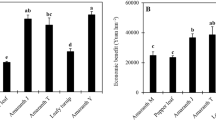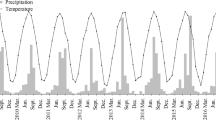Abstract
The nitrogen (N) use efficiency of field vegetable production systems needs to be increased in order to, reduce the detrimental effects of N losses on other ecosystems, save on production costs, and meet the limits set by the German government concerning N balance surpluses. Winter catch crops (CCs) have been shown to be a useful tool for reducing N losses in many agricultural production systems. This study was designed to test the effects of different CCs: rye (Secale cereale L.), fodder radish (Raphanus sativus L. var. oleiformis Pers.), bunch onion (Allium cepa L.), and sudangrass (Sorghum sudanense Stapf), planted at different sowing dates (early, late), on the N balance of 2-year vegetable crop rotation systems. The crop rotations started with a cauliflower (Brassica oleracea L. var. botrytis L.) crop, which was fertilized with N in a conventional manner. The experiments took place at three different sites in Germany. Results revealed that the average N balance surplus, when taking into consideration, fertilization, soil mineral N, and aboveground plant biomass N, was 217 kg N ha−1 in the control treatments without a CC. This high value was mainly a consequence of large quantities of crop N and soil mineral N remaining after the harvest of the cauliflower. In spite of these high N surpluses, the application of CC only reduced the N balance surplus, on average across all sites and experiments, by 13 kg N ha−1, when compared to the control treatments. The type of CC and the sowing date had only minor effects on the N balance. The findings of this study suggest that for many sites the application of CCs does not solve the problem of high N balance surpluses in intensive field vegetable production systems.




Similar content being viewed by others
References
Abrahamsen P, Hansen S (2000) Daisy: an open soil-crop-atmosphere system model. Environ Modell Softw 15:313–330
Beaudoin N, Saad JK, Van Laethem C, Machet JM, Maucorps J, Mary B (2005) Nitrate leaching in intensive agriculture in Northern France: effect of farming practices, soils and crop rotations. Agr Ecosyst Environ 111:292–310
BMU, BMELV (2008) Nitratbericht 2008 (in German), Gemeinsamer Bericht der Bundesministerien für Umwelt, Naturschutz und Reaktorsicherheit sowie für Ernährung, Landwirtschaft und Verbraucherschutz. Bonn, Germany
Cabrera ML, Kissel DE, Vigil MF (2005) Nitrogen mineralization from organic residues: research opportunities. J Environ Qual 34:75–79
Christiansen JS, Thorup-Kristensen K, Kristensen HL (2006) Root development of beetroot, sweet corn and celeriac, and soil N content after incorporation of green manure. J Hortic Sci Biotech 81:831–838
Council Directive 91/676/EEC (1991) Directive concerning the protection of waters against pollution caused by nitrates from agricultural sources. Official J L 375:1–8
De Neve S, Hofman G (1996) Modelling N mineralization of vegetable crop residues during laboratory incubations. Soil Biol Biochem 28:1451–1457
De Neve S, Pannier J, Hofman G (1996) Temperature effects on C- and N-mineralization from vegetable crop residues. Plant Soil 181:25–30
de Ruijter FJ, Huijsmans JFM, Rutgers B (2010) Ammonia volatilization from crop residues and frozen green manure crops. Atmos Environ 44:3362–3368
Fan AM, Steinberg VE (1996) Health implications of nitrate and nitrite in drinking water: an update on methemoglobinemia occurrence and reproductive and developmental toxicity. Regul Toxicol Pharm 23:35–43
Feller C, Fink M, Laber H, Maync A, Paschold P, Scharpf HC, Schlaghecken J, Strohmeyer K, Weier U, Ziegler J (2010) Düngung im Freilandgemüsebau (in German). In: Fink M (ed) Schriftenreihe des Leibniz-Instituts für Gemüse- und Zierpflanzenbau (IGZ), 3rd edn., issue 4. Großbeeren, Germany
Glasener KM, Palm CA (1995) Ammonia volatilization from tropical legume mulches and green manures on unlimed and limed soils. Plant Soil 177:33–41
Henriksen TM, Breland TA (1999) Decomposition of crop residues in the field: evaluation of a simulation model developed from microcosm studies. Soil Biol Biochem 31:1423–1434
Kätterer T, Bolinder MA, Andrén O, Kirchmann H, Menichetti L (2011) Roots contribute more to refractory soil organic matter than above-ground crop residues, as revealed by a long-term field experiment. Agr Ecosyst Environ 141:184–192
Kristensen HL, Thorup-Kristensen K (2004) Root growth and Nitrate uptake of three different catch crops in deep soil layers. Soil Sci Soc Am J 68:529–537
Kurunc A, Ersahin S, Uz BY, Sonmez NK, Uz I, Kaman H, Bacalan GE, Emekli Y (2011) Identification of nitrate leaching hot spots in a large area with contrasting soil texture and management. Agr Water Manage 98:1013–1019
Rahn CR, Vaidyanathan LV, Paterson CD (1992) Nitrogen residues from Brassica crops. Asp Appl Biol 30:263–270
Rankinen K, Salo T, Granlund K (2007) Simulated nitrogen leaching, nitrogen mass field balances and their correlation on four farms in south-western Finland during the period 2000–2005. Agr Food Sci 16:387–406
R Development Core Team (2010) R: A language and environment for statistical computing. R Foundation for Statistical Computing, Vienna, Austria. ISBN 3-900051-07-0, URL http://www.R-project.org
Schloemer S (1991) Denitrification losses from a horticultural soil as affected by incorporation of fresh plant residues. J Plant Nutr Soil Sci 154:265–269
Siegel S, Castellan NJ (1988) Non parametric statistics for the behavioural sciences. MacGraw Hill Int., New York, USA, pp 213–214
Simonne EH, Hochmuth GJ (2010) Soil and Fertilizer Management for Vegetable Production in Florida. University of Florida IFAS Extension. Electronic Document Information System, Document HS711. URL http://mansvu.mans.edu.eg/sites/recalsite/pdf%20course/38/CV10100.pdf. Accessed 19 Aug 2011
Smith VH, Tilman GD, Nekola JC (1999) Eutrophication: impacts of excess nutrient inputs on freshwater, marine, and terrestrial ecosystems. Environ Pollut 100:179–196
Thorup-Kristensen K (1993) The effect of nitrogen catch crops on the nitrogen nutrition of a succeeding crop. Acta Agr Scand B Soil Plant Sci 43:74–81
Thorup-Kristensen K (2001) Are differences in root growth of nitrogen catch crops important for their ability to reduce soil nitrate-N content, and how can this be measured? Plant Soil 230:185–195
Thorup-Kristensen K (2006) Effect of deep and shallow root systems on the dynamics of soil inorganic N during 3-year crop rotations. Plant Soil 288:233–248
Thorup-Kristensen K, Nielsen NE (1998) Modelling and measuring the effect of nitrogen catch crops on the nitrogen supply for succeeding crops. Plant Soil 203:79–89
Thorup-Kristensen K, Magid J, Jensen LS (2003) Catch crops and green manures as biological tools in nitrogen management in temperate zones. Adv Agron 79:227–302
Van Schöll L, Van Dam AM, Leffelaar PA (1997) Mineralisation of nitrogen from an incorporated catch crop at low temperatures: experiment and simulation. Plant Soil 188:211–219
Velthof GL, Kuikman PJ, Oenema O (2002) Nitrous oxide emission from soils amended with crop residues. Nutr Cycl Agroecosys 62:249–261
Vitousek PM, Aber JD, Howarth RW, Likens GE, Matson PA, Schindler DW, Schlesinger WH, Tilman GD (1997) Human alteration of the global nitrogen cycle: sources and consequences. Ecol Appl 7:737–750
Acknowledgments
Special thanks go to Gerlinde Brandt and Ute Engel for technical assistance. We are very grateful to Norbert Laun for scientific discussion as well as realization of field experiments and also to Nysha Munro for suggestions on this manuscript. Financial support from the German Federal Agency for Agriculture and Food (BLE) is gratefully acknowledged.
Author information
Authors and Affiliations
Corresponding author
Rights and permissions
About this article
Cite this article
Nett, L., Feller, C., George, E. et al. Effect of winter catch crops on nitrogen surplus in intensive vegetable crop rotations. Nutr Cycl Agroecosyst 91, 327–337 (2011). https://doi.org/10.1007/s10705-011-9464-y
Received:
Accepted:
Published:
Issue Date:
DOI: https://doi.org/10.1007/s10705-011-9464-y




